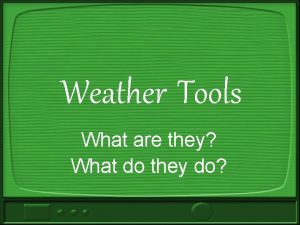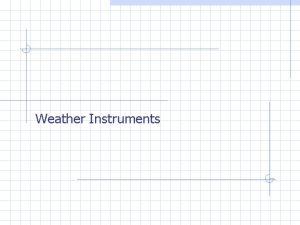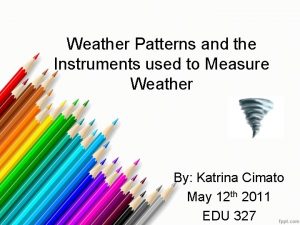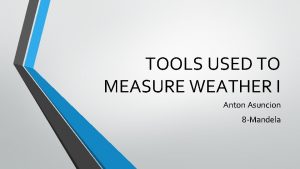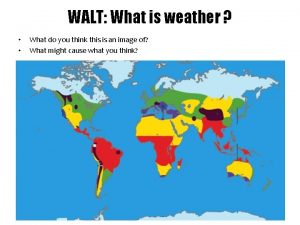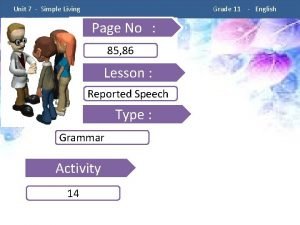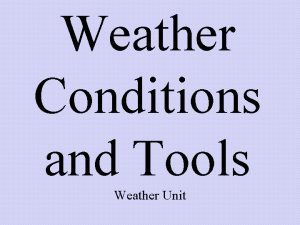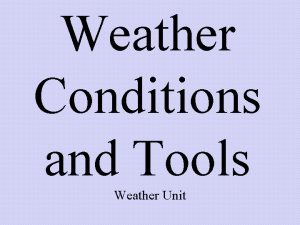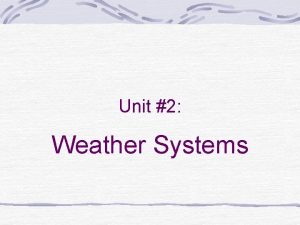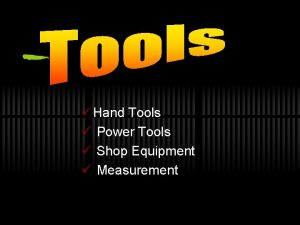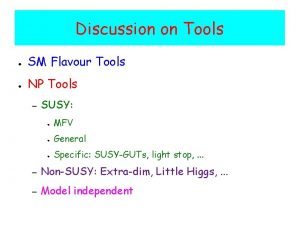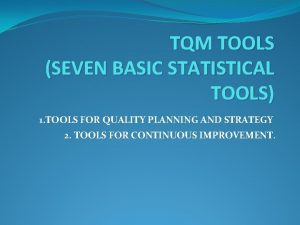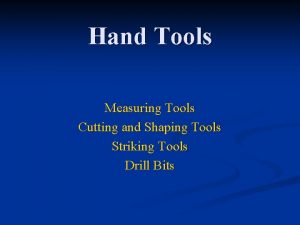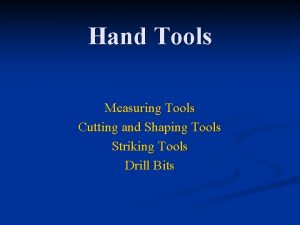Weather Tools 2 nd Grade Weather Unit Weather
























- Slides: 24

Weather Tools 2 nd Grade Weather Unit

Weather changes occur day to day and from season to season.

In order to understand daily weather conditions, weather data must be collected accurately using weather instruments.

Wind Speed the condition of how fast the air is moving

Wind Speed measured with the Beaufort Scale

Beaufort Scale Wind speed Description Visual cues 0 1 mph Calm winds Smoke rises vertically 1 2 mph Light winds Smoke drifts 2 5 mph Light breeze Leaves rustle 3 10 mph Gentle breeze Lighter branches sway 4 15 mph Moderate breeze Dust rises. Branches move 5 21 mph Fresh breeze Small trees sway 6 28 mph Strong breeze Larger branches move 7 35 mph Moderate gale Trees move 8 42 mph Fresh gale Twigs break 9 50 mph Strong gale Branches break 10 59 mph Whole gale Trees fall 11 69 mph Storm Violent blasts 12 75+ mph Hurricane Structures shake

Wind Direction the condition determined by where the wind/moving air is coming from

Wind vane Wind direction is determined with a wind vane (weather vane). Wind direction is described by the direction from which the wind is blowing.

Wind vane How does it work?

Using a Wind Sock

Precipitation The condition of the type of water falling to Earth from the clouds

Rain gauge Amount of precipitation is measured in a rain gauge. Markings on the side show much rain has fallen.

Rain gauge How does it work? Rain falls and collects in the rain gauge. Markings on the side show the amount of rain that has fallen. Measures rainfall in inches.

Temperature The condition of how warm or cold the air is at a given time

Thermometer Air temperature is read using a thermometer. The scale may be read in degrees Fahrenheit or Celsius. Air temperature should be measured out of direct sunlight.

Thermometer How does it work?

Answer the following question about weather tools. 1. Monday it rained all day and all night. Ms. Salisbury’s class was learning about weather and they wanted to find out how much it rained Monday. Which tool should they use to measure the rain? a. thermometer b. wind vane c. rain gauge d. wind sock

Answer the following question about weather tools. 2. Mrs. Tedder’s class went outside for recess. It was very windy outside and the students wanted to find out how fast the wind was blowing. Which weather tool should the students to use to find their answer? a. Beaufort Scale b. wind vane c. rain gauge d. wind sock

Answer the following question about weather tools. 3. Mrs. Mc. Cormick’s class wanted to fly their kites outside. They wanted to find out which direction the wind would blow their kite in. Which weather tool should the students to use to find their answer? a. Beaufort Scale b. wind vane c. rain gauge d. wind sock

Answer the following question about weather tools. 4. The weather it turning colder and you need to know what to wear to school. Which weather tool should the students to use to find their answer? a. wind vane b. thermometer c. Beaufort Scale d. wind sock

Answer the following question about weather tools. 5. What do we use the Beaufort Scale for? a. To measure the temperature of the outside weather. b. To find out the direction the wind is blowing in. c. To measure the wind speed. d. To measure how much precipitation has fallen.

Answer the following question about weather tools. 6. What do we use a rain gauge for? a. To measure the temperature of the outside weather. b. To find out the direction the wind is blowing in. c. To measure the wind speed. d. To measure how much precipitation has fallen.

Answer the following question about weather tools. 7. What do we use a thermometer for? a. To measure the temperature of the outside weather. b. To find out the direction the wind is blowing in. c. To measure the wind speed. d. To measure how much precipitation has fallen.

Answer the following question about weather tools. 7. What do we use a wind vane for? a. To measure the temperature of the outside weather. b. To find out the direction the wind is blowing in. c. To measure the wind speed. d. To measure how much precipitation has fallen.
 Unit 10, unit 10 review tests, unit 10 general test
Unit 10, unit 10 review tests, unit 10 general test Cutting tools in sewing with pictures and meaning
Cutting tools in sewing with pictures and meaning Weather tools and what they do
Weather tools and what they do Weather measurement tools
Weather measurement tools Tools to measure weather
Tools to measure weather Tools to measure weather
Tools to measure weather Weather channel asuncion
Weather channel asuncion Convectional rainfall
Convectional rainfall Transmutation table deped 2020
Transmutation table deped 2020 Cinderella dressed in yellow game
Cinderella dressed in yellow game Difference between grade a and grade aa eggs
Difference between grade a and grade aa eggs Milk grades
Milk grades Grade grade
Grade grade Meta - change morph -
Meta - change morph - Unit 5 tools and equipment
Unit 5 tools and equipment Weather station model symbols
Weather station model symbols Spring tongue twisters
Spring tongue twisters Poem about clothes
Poem about clothes It's windy and rainy
It's windy and rainy Whether the weather
Whether the weather Heavy weather by weather report
Heavy weather by weather report Capital weather gang weather wall
Capital weather gang weather wall Examples of internal forms of social control
Examples of internal forms of social control Grade 11 english unit 1
Grade 11 english unit 1 Grade 11 english unit 7
Grade 11 english unit 7


